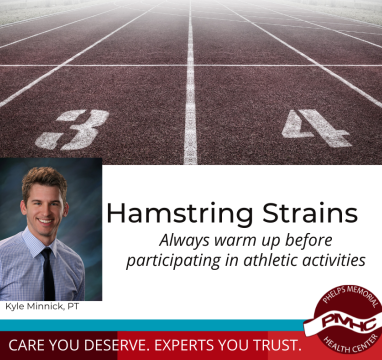With spring season sports upon us, athletes and coaches are busy getting ready for the season by setting new goals, going over fundamentals, and more than likely doing a lot of conditioning and/or strength training. Unfortunately it doesn't take much for an injury to happen while training. A hamstring muscle injury, for example, is a common injury in athletes this time of year. Rehabilitation Director at Phelps Memorial Therapy Services Kyle Minnick, PT, tells us how this kind of injury happens and what to do to lower your risk.
Hamstring strain injuries occur when there is damage to the muscle belly caused by excessive force being generated while the muscle is being stretched. This typically happens during high-speed running, with sudden starts or changes in direction, or when the muscle is overstretched by activities such as sprinting, hurdling, kicking, or heavy lifting.
Risk factors for hamstring strain injuries include:
- A history of prior hamstring strain injury.
- Poor flexibility of the hamstrings, quadriceps, and/or hip flexors.
- Weak hamstrings.
- A muscular strength imbalance between the quadriceps and the hamstrings, where the quads overpower a weaker hamstring during running.
- Inadequate warm up before activity.
- Muscle fatigue.
You can decrease your risk of a hamstring strain injury in the following ways:
- Always warm up before participating in athletic activities.
- Focus on good flexibility exercises to the hamstrings, quadriceps, and the hip.
- Avoid starting a new activity too quickly; gradually increase the frequency and intensity of the activity so that your body may adapt to the new movement patterns.
- Build the strength of your hamstring muscles.
- Listen to your body after you work out (and stretch, apply ice, rest as needed) prior to engaging in the same routine again.
If you have any concerns or would like a free athletic screening done, please contact the Phelps Memorial Therapy Center at 308.995.2865.



